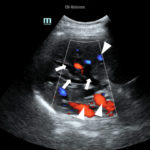Point-of-Care Ultrasound to Evaluate Intrahepatic Biliary Stent Function
History of present illness:
A 90-year-old male with a past medical history of cholangiocarcinoma status post biliary stent placement presented to the emergency department (ED) for worsening abdominal pain and jaundice for two days. Patient noted that pain was similar to what was experienced with his diagnosis of cholangiocarcinoma the year prior. The patient’s vitals on arrival to the ED were a temperature 36.4°C, blood pressure 180/80 mmHg, heart rate 80 beats per minute, respiratory rate 16 breaths per minute, and oxygen saturation of 96% on room air. On physical exam, the patient was alert, oriented and in no acute distress. He was noted to have jaundice as well as scleral icterus. There was no appreciable abdominal tenderness, distention and Murphy’s sign was negative. His blood work was notable for elevated liver function tests with an alkaline phosphatase at 652 units per liter, aspartate aminotransferase at 159 units per liter, alanine aminotransferase at 232 units per liter, and total bilirubin at 9.4 milligrams per deciliter. A point-of-care ultrasound was performed of the right upper quadrant due to the patient’s history of malignancy and elevated liver function tests (image).
Significant findings:
The ultrasound image demonstrates severe intrahepatic biliary ductal dilatation without an obvious intrahepatic obstructive lesion, as pointed out by the white arrows. The hepatic vasculature is well-distinguished from the biliary tree via color flow doppler, as seen by the white arrowheads.
Discussion:
Cholangiocarcinoma is the second most common primary liver malignancy with historically poor prognosis despite aggressive multi-treatment approaches.1 Biliary obstruction occurs in up to 90% of patients with cholangiocarcinoma and endoscopic placement of a biliary stent is a commonly performed therapeutic intervention.1,2 Despite recent advancements in stent technology, many complications can still occur including stent dysfunction, clogging, tissue ingrowth, tissue overgrowth, and migration.2 These complications are not infrequent, and depending on the type of stent, can have stent dysfunction in up to 41% of patients, clogging in 33%, tissue ingrowth in 18%, tissue overgrowth in 7%, and migration in 17%, all potentially causing a biliary obstruction.2 Currently, endoscopic retrograde cholangiopancreatography (ERCP) is the criterion standard for evaluation of cholangiocarcinoma with obstructive jaundice. However, ultrasonography can prove beneficial when assessing for malfunctioning biliary stents which can be seen as ductal dilatation.3 Point-of-care ultrasound (POCUS) in an emergency department setting is rapid, noninvasive, inexpensive, and has upwards of 65% sensitivity and 98% specificity for detecting extrahepatic biliary obstruction.4 As a result, the utility of point of care ultrasonography in an emergency care setting can quickly rule-in biliary obstruction and expedite intervention to prevent permanent damage. It is however important to note that with such a low sensitivity, POCUS cannot be used to rule out stent malfunction.
The patient’s presentation was concerning for biliary obstruction which was confirmed via point of care ultrasound. He was subsequently admitted to the hospital with gastroenterology consultation and underwent endoscopic ultrasound and (ERCP) where a stricture was found within the stent. Two more biliary stents were placed to correct this defect. The patient’s liver function tests began to trend downwards with clinical resolution, and patient was eventually discharged home without any complications.
Topics:
Ultrasound, biliary, GI, abdominal.
References:
- Patel T. Cholangiocarcinoma—controversies and challenges. Nat Rev Gastroenterol Hepatol. 2011;8(4):189-200. doi: 10.1038/nrgastro.2011.20.
- Nam HS, Kang DH. Current status of biliary metal stents. Clin Endosc. 2016;49(2):124-130. doi: 10.5946/ce.2016.023.
- Tajiri T, Yoshida H, Mamada Y, Taniai N, Yokomuro S, Mizuguchi Y. Diagnosis and initial management of cholangiocarcinoma with obstructive jaundice. World J Gastroenterol. 2008;14(19):3000-3005. doi: 10.3748/wjg.14.3000.
- Potthoff A, Hahn A, Kubicka S, et al. Diagnostic value of ultrasound in detection of biliary tract complications after liver transplantation. Hepat Mon. 2013;13(1): e6003. doi: 10.5812/hepatmon.6003.




